
Disha Gupta


Employees are switching companies, roles, and industries at a higher frequency than ever before. This has highlighted the need for HR teams to build new strategies to retain their highest-performing employees.
One of the most important, impactful areas of employee retention is investing in its talent with a comprehensive employee development strategy.
Different employee have unique set of strengths, experiences, and skill gaps, just like every position requires a unique set of competencies. Because of this, it often makes the most sense to pinpoint specific areas of development in corporate L&D strategies to build contextual employee development plans that encourage growth and empower internal employees to fully realize their potential through upskilling, new skill development, and the refinement of these skills.
In this article, we’ll explore the key areas of employee development that organizations should focus on to build future leaders and high-performers from within your current workflow.

Employee development areas, also called competencies, are core skill and knowledge areas that employees need to do their jobs effectively. Organizations can provide employees with development opportunities to upskill and improve existing knowledge and experience in specific development areas.
Identifying and targeting these different areas is a fundamental part of developing an effective L&D strategy. Engaging in development activities helps employees understand which areas they excel in, and which ones have room for improvement.
Employee development areas may differ from employee to employee or from position to position. Here are some of the most consistently critical development areas employees need to excel in the workplace – with examples of types of development and training for each:
First things first, all employees need to be proficient in the skills required to carry out day-to-day job duties. After initial onboarding, employees should regularly engage in development activities that can help them improve and expand on those skills, especially as technology and methods evolve.
Some examples of professional skills include database management, data analysis, and industry-specific operational skills.
Examples of professional skills development training include:
Being able to effectively collaborate and communicate is absolutely essential for employees who operate as members of a team. Encouraging employees to develop these skills leads to more efficient and active dissemination of information and encourages dialogue that can lead to innovation.
Targeting written and verbal communication as well as active listening and interpersonal skills in L&D programming can help organizational leaders build a safe environment for productive dialogue and effective teamwork.
Examples of collaboration and communication development and training include:
Employees who can organize their workspaces and minds, and lay out strategic professional goals for themselves are instrumental in the achievement of larger organizational goals. By including goal setting and organizational skills in development efforts, L&D teams can help employees become more self-sufficient, ultimately reducing stress and increasing productivity.
Some examples of goal-setting and organizational skills include schedule and deadline management, multitasking, task prioritization, and productivity. Across all of these skills, time management plays a huge part.
Examples of goal setting and organization skills development and training include:
When working as part of a team, conflicts are bound to arise from time to time. At this point, employees need to tap not only into communication skills but empathy and professionalism as well. Building conflict resolution skills into employee development allows employees and managers to address and de-escalate conflicts, reducing tension, improving morale, and building stronger teams in the long run.
Common skills related to this employee development area include stress management, emotional awareness, active listening, and patience.
Examples of conflict-resolution development and training include:
Today’s workplaces are becoming increasingly dynamic, requiring employees to be flexible and agile to thrive. By including adaptability-related skills in employee development, team members become better equipped to handle complex situations, acclimatize quickly, and stay productive in the face of challenges.
Some skills that fall into this area are improvisation, direct action, and the ability to learn new skills.
Examples of adaptability development and training include:

Productivity is a critical employee development area because it is relevant to every aspect of work and ultimately determines the success of an organization. When employees can hone their productivity skills, they not only have a positive impact on business outcomes but also tend to become more engaged and satisfied at their work.
Key skill sets related to productivity include time management, planning, and self-awareness.
Examples of productivity and time management development and training include:
By training employees to understand and carry out tasks that lie outside their regular job responsibilities, L&D teams can help employees gain new perspectives on workplace challenges and be prepared to take on new responsibilities as needed. This employee development area is especially important in times when positions become vacant and remaining employees need to pitch in to keep things running smoothly.
Skills useful for the accumulation of cross-functional knowledge are agility, communication, and of course, the relevant core professional skills.
Examples of cross functional knowledge development and training include:
Employees at every level can benefit by developing their leadership skills. By giving employees opportunities to hone their management skills, they become better communicators, problem solvers, and team members.
Successful leaders tend to have strong strategic thinking skills, developmental planning, decision-making, and delegation.
Examples of leadership development and training include:
Creativity is a development area that impacts just about every aspect of work. Encouraging creative thinking among employees empowers them to address common issues in innovative ways and helps keep businesses competitive in evolving industries.
Skills that contribute to this employee development area are pattern identification, imagination, critical thinking, and confidence.
Examples of creativity development and training include:
Of course, the particular skill areas that will be most important to focus on may differ across organizations. Before charging ahead in any one direction, it is essential to perform thorough assessments to determine which employee development areas are the most relevant to the needs of individual team members and the goals of the larger organization. From there, L&D teams can build out the most effective employee development strategy for their organizations.
Businesses that utilize digital adoption platforms like Whatfix for employee development benefit from a streamlined learning process. Whatfix’s in-app guidance can provide employees with customized learning paths to meet their unique upskilling needs. This software delivers interactive, personalized learning experiences that make employee development intuitive and accessible.
With a digital adoption platform like Whatfix, enable your employees with in-app guidance and contextual self-help IT support to accelerate the adoption of new software implementations, employee onboarding, change initiates, and more. Whatfix’s no-code editor enables IT teams with a no-code editor to create product tours, interactive walkthroughs, task lists, smart tips, pop-ups, self-help wikis, and more. Analyze and measure user engagement and software usage to identify friction points, measure digital adoption, and improve employee digital experiences.
Thank you for subscribing!